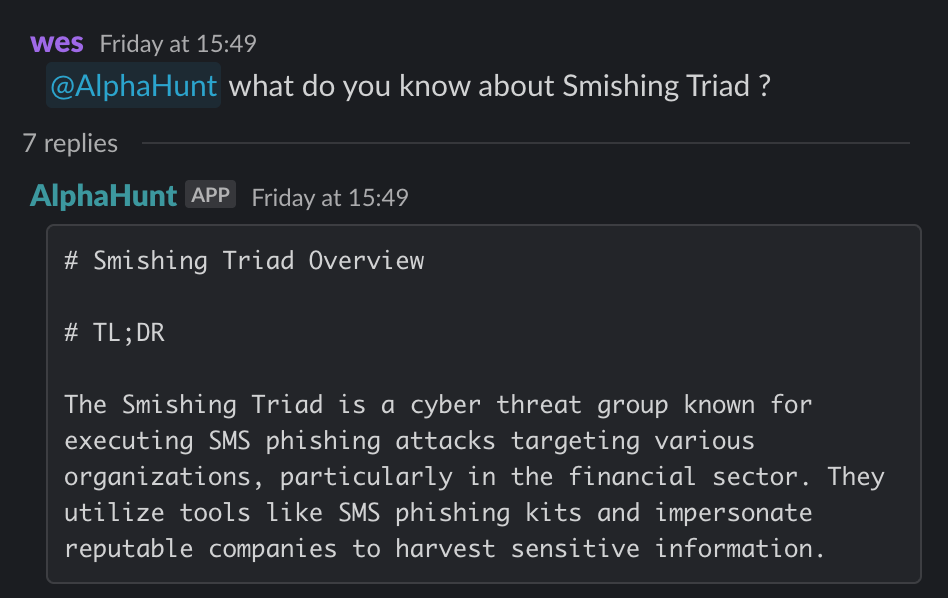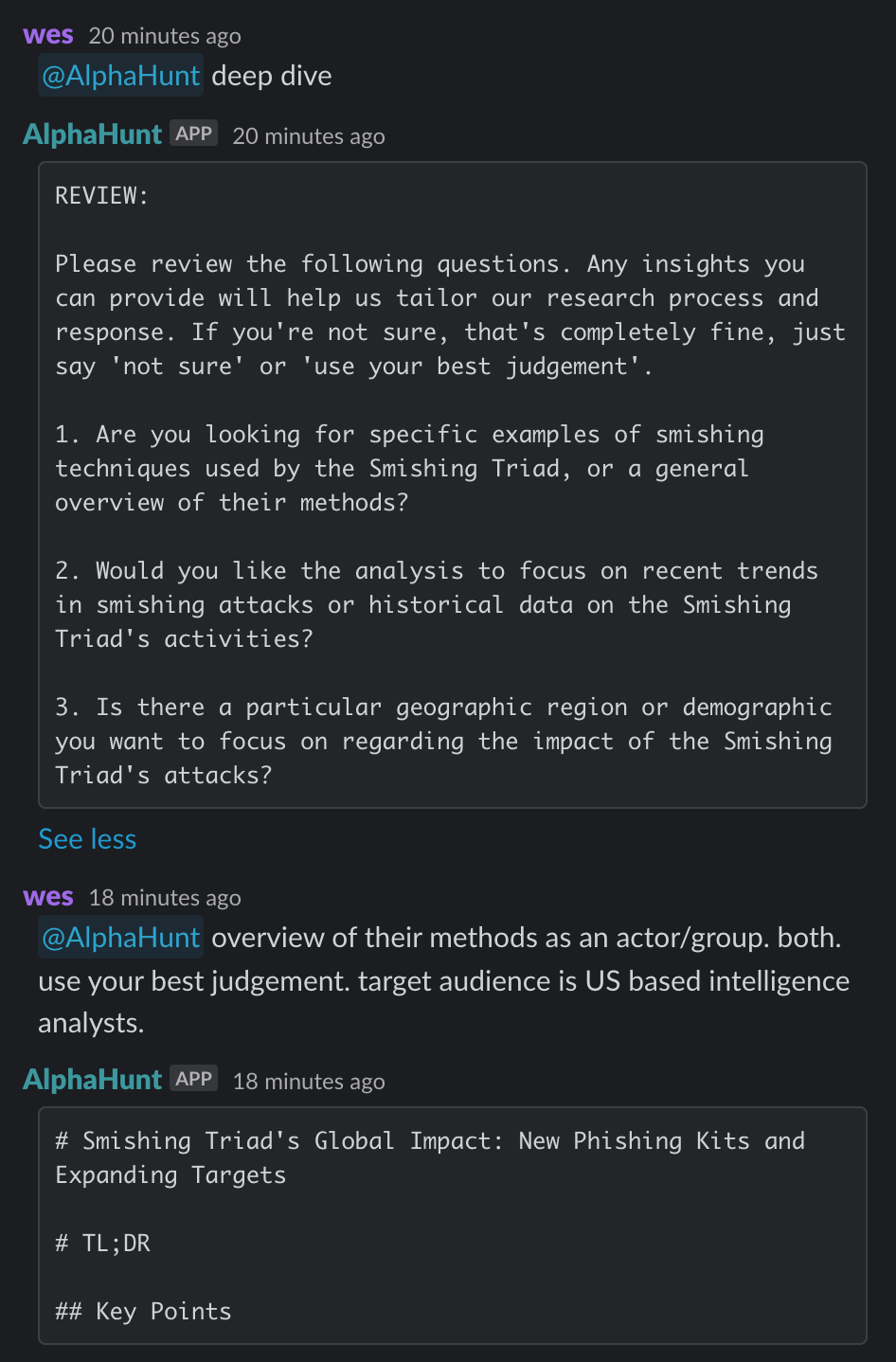Smishing Triad's Global Impact: New Phishing Kits and Expanding Targets
The Smishing Triad, a cybercriminal group, is leveraging advanced smishing techniques to deceive victims by impersonating legitimate organizations. They exploit platforms like iMessage using compromised Apple iCloud accounts to send spam messages that bypass traditional filters..



Think of all the things you could learn- if you just had the time... (and the bot ;))
(Have feedback? Did something resonate with you? Did something annoy you? Just hit reply! :))
Get questions from your boss, like this:
- what do you know about Smishing Triad ?
Are you ready to level up your skillset? Get Started Here!
Smishing Triad's Global Impact: New Phishing Kits and Expanding Targets
TL;DR
Key Points
-
- The Smishing Triad employs sophisticated smishing tactics, using impersonation and platforms like iMessage to bypass spam filters.
- Organizations should enhance SMS filtering and user education to mitigate these threats.
-
- The group has launched the "Lighthouse" phishing kit, enabling real-time data theft and targeting major financial institutions.
- Financial sectors must prepare for increased smishing campaigns and adopt multi-factor authentication.
-
- The Triad's operations span over 121 countries, with a focus on financial, logistics, and public service sectors.
- Global collaboration and intelligence sharing are crucial to counteract their widespread impact.
-
- Future trends suggest potential expansion into healthcare and e-commerce, leveraging AI for more convincing attacks.
- Organizations in these sectors should proactively strengthen defenses and monitor emerging threats.
Executive Summary
The Smishing Triad, a cybercriminal group, is leveraging advanced smishing techniques to deceive victims by impersonating legitimate organizations. They exploit platforms like iMessage using compromised Apple iCloud accounts to send spam messages that bypass traditional filters. Their recent introduction of the "Lighthouse" phishing kit enhances their capabilities, allowing real-time synchronization of stolen data and supporting multiple verification methods. This kit is marketed to other cybercriminals, expanding their operational reach.
The group has been linked to a surge in smishing campaigns targeting toll service providers in the U.S. and the U.K., with operations expanding to over 121 countries. They focus on financial institutions, particularly in Australia and the Asia-Pacific region, sending over 100,000 SMS messages daily. The Lighthouse kit targets major financial institutions, including Commonwealth Bank of Australia and HSBC, making it a formidable tool for cybercriminals.
The Smishing Triad targets sectors such as finance, logistics, telecommunications, and public services, impersonating organizations like USPS and FedEx. Their activities have led to significant financial losses, with traditional spam filters struggling to detect these messages. Recommendations include user education, advanced SMS filtering, multi-factor authentication, and collaboration with law enforcement.
Future trends indicate potential expansion into healthcare and e-commerce, with the group possibly leveraging AI to enhance their phishing schemes. Organizations should prepare for increased regulatory scrutiny and adopt advanced security measures to protect against these evolving threats.
Suggested Pivot
What specific technical features of the Lighthouse phishing kit enhance its effectiveness compared to previous kits, and how can organizations develop countermeasures to mitigate these specific tactics?
Research
Operational Methods
-
Operational Tactics: The Smishing Triad uses SMS phishing (smishing) techniques, employing impersonation tactics to deceive victims. They often impersonate legitimate organizations, such as postal services and toll agencies, to create urgency and legitimacy.
-
Exploitation of Platforms: The group exploits platforms like iMessage by using compromised Apple iCloud accounts to send spam messages. This method allows them to bypass traditional spam filters, making their messages appear more credible.
-
Phishing Kits: Recently, they introduced the "Lighthouse" phishing kit, which enhances their capabilities by allowing real-time synchronization of stolen data and supporting multiple verification methods (e.g., OTP, PIN). This kit is marketed to other cybercriminals, expanding their operational reach.
Activities and Campaigns
-
Surge in Toll Payment Scams: The Smishing Triad has been linked to a significant increase in smishing campaigns targeting toll service providers in the U.S. and the U.K. Victims receive messages claiming they owe unpaid tolls, directing them to phishing sites designed to harvest personal and financial information.
-
Global Reach: Their operations have expanded to over 121 countries, with a notable focus on financial institutions in Australia and the Asia-Pacific region. They reportedly send over 100,000 SMS messages daily, with server logs indicating even higher activity levels.
-
New Phishing Kit Launch: In March 2025, the group launched the Lighthouse phishing kit, which targets major financial institutions, including Commonwealth Bank of Australia and HSBC. This kit is designed for ease of use and rapid deployment, making it a formidable tool for cybercriminals.
Targets
-
Geographical: The Smishing Triad targets a wide array of countries, including the U.S., Canada, Australia, and various nations in Europe, Asia, and Latin America. Their operations cover nearly two-thirds of the world's countries, indicating a broad and adaptable targeting strategy.
-
Sectors: The group primarily targets sectors such as finance, logistics, telecommunications, and public services. They have impersonated numerous organizations, including USPS, FedEx, and various toll agencies, to lure victims into providing sensitive information.
Impact on U.S.-Based Organizations
-
Financial Losses: The activities of the Smishing Triad have led to significant financial losses for individuals and organizations, particularly in the toll payment and financial sectors. The impersonation of trusted entities increases the likelihood of victims falling for these scams.
-
Challenges in Mitigation: The nature of smishing makes it difficult for traditional spam filters to catch these messages, as they often appear legitimate. The use of spoofed sender IDs further complicates detection efforts.
-
Recommendations for Countermeasures:
- User Education: Organizations should implement training programs to educate employees and customers about recognizing smishing attempts and verifying communications from unknown sources.
- Enhanced Security Measures: Employ advanced filtering technologies that can detect and block suspicious SMS messages. Encourage the use of multi-factor authentication to protect sensitive accounts.
- Collaboration with Law Enforcement: Organizations should work closely with law enforcement and cybersecurity agencies to report incidents and share intelligence on emerging threats.
Recommendations, Actions, Suggested Pivots, Forecasts and Next Steps..
(Subscribers Only)





![[DEEP RESEARCH] Zero-Days Are a Distraction: 2025’s Biggest Losses Were Stolen Tokens + OAuth](/content/images/size/w600/2025/12/zz-3.png)